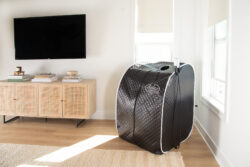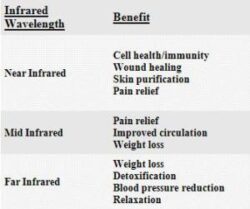6 Ways Saunas Help Fight Cancer – Part Four
November 17, 2014 | Author: Susan Silberstein PhD
In previous blogs, I discussed many anti-cancer benefits of saunas, including direct cancer cell death, improved circulation, toxin elimination, weight loss, and immune activation. Now I want to talk about one more benefit, relaxation. Perhaps that sounds too obvious and too simple, but besides providing a pleasant experience, the relaxation produced through a sauna session actually has very specific anti-cancer effects.
Inside a sauna, there is peacefulness. One can easily shut out daily cares and interruptions from the world outside. One can read, listen to music, meditate or pray without interruption. But saunas do more for your nerve system than make you feel good.
Saunas have the ability to powerfully reduce the activity of the sympathetic nerve system. Excessive activity of the sympathetic nervous system is a contributing factor in many cancer cases. The sympathetic branch of the body’s autonomic nervous system activates the brain, muscles, thyroid and adrenal glands in its fright – fight – flight response to stress. However, it also strongly inhibits digestion, immune response and eliminative organ function. Cancer patients desperately need more immune, digestive and eliminative activity.
Therefore therapies such as infrared sauna that inhibit the sympathetic nervous system are helpful for cancer recovery. The body heals when it is in parasympathetic dominance, the part of the nerve system that promotes rest, relaxation and recovery.
Saunas can support parasympathetic activity in several ways. Sauna heat greatly slows normal heat production, a sympathetic function. To dissipate heat, saunas draw blood from the center to the periphery of the body. This opposes an important sympathetic nervous system activity, which is to draw blood to the central part of the body as a protection against attack. Furthermore, saunas eliminate toxins that irritate the body’s tissues and keep it in a sympathetic state. Inhibiting the sympathetic nervous system can also promote cancer healing by helping to reduce excess acidity in the body. Cancer, as we know, thrives in an acid environment.
can support parasympathetic activity in several ways. Sauna heat greatly slows normal heat production, a sympathetic function. To dissipate heat, saunas draw blood from the center to the periphery of the body. This opposes an important sympathetic nervous system activity, which is to draw blood to the central part of the body as a protection against attack. Furthermore, saunas eliminate toxins that irritate the body’s tissues and keep it in a sympathetic state. Inhibiting the sympathetic nervous system can also promote cancer healing by helping to reduce excess acidity in the body. Cancer, as we know, thrives in an acid environment.
The effect of saunas on the nerve system can also potentially impact appetite loss, pain and depression, all of which are common among patients with cancer. A study published in Psychosomatic Medicine looked at a group of 28 mildly depressed patients. Half of the patients utilized an infrared sauna once a day for four weeks and the other half had just bed rest for four weeks. The sauna group showed a significant improvement compared with the control group.
Types of Saunas
The difference between an infrared sauna and the traditional Finnish-style sauna is that the latter heats you up from the outside in, like an oven. The infrared sauna heats you from the inside out. In traditional saunas, people find the heat much more uncomfortable at high temperatures than in infrared saunas. This is because an infrared sauna uses light to create heat, whereas a traditional sauna uses heat to warm the air, which in turn warms your body. An infrared sauna heats your body directly without warming the air around you. According to Brent A. Bauer, M.D., of the Mayo Clinic, infrared saunas produce reactions such as vigorous sweating and increased heart rate at lower temperatures than do regular saunas, which makes these results accessible to people who can’t tolerate the heat of a conventional sauna.
Light-source saunas, as opposed to traditional saunas, are sometimes called far-infrared saunas. “Far” describes where the infrared waves fall on the light spectrum. Most infrared saunas on the market produce only far infrared. However, a new development in the field is full-spectrum infrared. These are saunas that provide all of the benefits associated with far-, mid- and near-infrared rays. Some experts recommend near-infrared energy because it better stimulates the body’s natural healing powers. In cancer treatment, near-infrared is sometimes used for healing chemotherapy-induced ulcers and wound healing. Dr. William Donald Kelley, who cured thousands of cancer patients with natural methods, endorsed only the near infrared sauna for cancer patients.
Lee Euler, editor of CancerDefeated.com, shares the following chart comparing the benefits of near-, mid-, and far-infrared wavelengths.

We have not seen enough research to confirm this chart’s accuracy, but we have seen excellent results with all types of saunas.
Join the conversation: Ask Holistic Cancer Coach Facebook Group
References:
[1] Guyton, A. Textbook of Medical Physiology, 6th ed, p. 892
[2] http://en.wikipedia.org/wiki/Infrared#cite_note-24#cite_note-24
[3] http://www.cancerdefeated.com/the-incredible-healing-power-of-infrared-saunas/1734/
[4] http://www.mayoclinic.org/healthy-living/consumer-health/expert-answers/infrared-sauna/faq-20057954
[5] http://www.rethinkingcancer.org/resources/magazine-articles/2008/sauna.php
[6] Imamura, M, et al. Repeated thermal therapy improves impaired vascular endothelial function in patients with coronary risk factors. Journal of the American College of Cardiology. 2001, 38 (4): 1983-88
[7] Masuda A, et al. “Repeated thermal therapy diminishes appetite loss and subjective complaints in mildly depressed patients.” Psychosomatic Medicine. 2005 67 (4): 643-47
[8] Whelan, et al. Photobiomodulation Directly Benefits Primary Neurons Functionally Inactivated by Toxins: Role of Cytochrome C Oxidase. JBC Papers in Press. Published on November 22, 2004 as Manuscript M409650200. Copyright 2004 by The American Society for Biochemistry and Molecular Biology, Inc.

